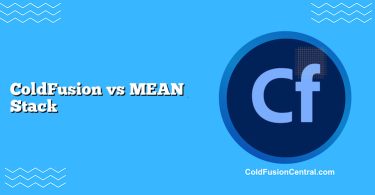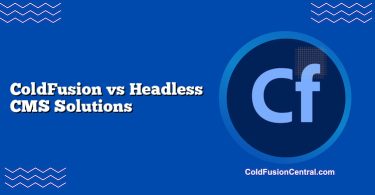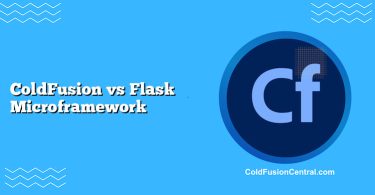Definitions
- ColdFusion backend: A server-side application stack built on Adobe ColdFusion or Lucee (open-source), using CFML/CFScript to render pages, expose REST APIs, integrate with databases, and run business logic on the JVM.
- GraphQL backend: An API layer that exposes a strongly-typed schema (queries, mutations, subscriptions). Clients ask for exactly the data they need; the server resolves fields via resolvers to various data sources (databases, services, third-party APIs).
Overview
What is a ColdFusion backend?
ColdFusion is both a language (CFML/CFScript) and an application server (Adobe ColdFusion, Lucee) that runs on Java. A “ColdFusion backend” typically means:
- A monolithic web application or REST API written in CFML/CFScript.
- Built-in integrations like ORM (Hibernate), mail, PDF, scheduling, and caching.
- Deployed on-premises or via containers, often in enterprises with legacy CFML codebases.
- Strengths: rapid development, lots of batteries-included features, ease of CRUD/API building.
What is a GraphQL backend?
GraphQL is not a server; it’s a specification and a query language for APIs. A “GraphQL backend” usually refers to:
- A runtime and schema implemented in Node.js (Apollo Server), Java (graphql-java), .NET (Hot Chocolate), Python (Graphene), Go (gqlgen), or managed services (AWS AppSync, Hasura).
- A single endpoint exposing a typed schema. Clients request exactly the fields they need.
- A unifying API layer across microservices, databases, and third-party APIs.
- Strengths: flexible queries, fewer round trips, great developer tooling and introspection.
Key Features
ColdFusion
- Built-in ORM (Hibernate), task scheduling, PDF/image manipulation, email, and caching.
- Rapid development with CFML/CFScript and simple database access (cfquery, cfqueryparam).
- Mature session management, application lifecycle hooks, form handling, and file I/O.
- Easy REST endpoints (cfcomponent/cffunction with REST annotations).
- Deployable on JVM across Windows/Linux/macOS, and containerized images.
GraphQL
- Strongly-typed schema with introspection and self-documenting capabilities.
- Fine-grained data fetching: avoid over-fetching and under-fetching.
- Powerful tooling: GraphiQL, GraphQL Playground, Apollo Federation, schema stitching.
- Declarative data fetching for web/mobile clients; built-in subscriptions for real-time.
- Fits microservices and API gateway patterns; can sit in front of REST, gRPC, or databases.
Architecture and Development Model
Data fetching
- ColdFusion: Typically REST endpoints returning JSON, each endpoint shaped for specific screens. Caching often HTTP/edge-friendly (status codes, ETags).
- GraphQL: One endpoint with a schema. Clients query exactly the fields; resolvers fetch from various sources. Requires attention to N+1 query issues (DataLoader pattern).
Templating and rendering
- ColdFusion: Can render server-side HTML (CFML), serve REST, or both. Great for server-rendered dashboards and back-office tools.
- GraphQL: Usually headless API-first. Works with any frontend (React, Vue, native apps), leveraging client libraries (Apollo Client, Relay).
Performance
- ColdFusion performance:
- JVM-based, mature JIT compilation, strong throughput for monolithic apps.
- REST endpoints are straightforward and cache well via HTTP semantics.
- Tight coupling with ORM can be very fast if queries are optimized; can be slower if heavy object graphs are fetched naïvely.
- GraphQL performance:
- Adds parsing/validation overhead per request; mitigated by persisted queries and caching.
- Reduces bandwidth by fetching exactly the requested fields.
- Potential bottlenecks from N+1 resolver patterns; addressed with batching/caching (DataLoader), query complexity limits, and field-level caching.
When latency and CDN caching are paramount for read-heavy endpoints, REST on ColdFusion may outperform GraphQL due to simpler caching. For complex, variable client data needs, GraphQL can reduce multiple round trips and payload sizes.
Scalability
-
ColdFusion scalability:
- Vertical scaling is easy; horizontal scaling via session replication, sticky sessions, or stateless design.
- Works well as a monolith; scaling teams may require modularization or microservices around the edges.
- Containerization (Docker) is standard; can run behind load balancers and API gateways.
-
GraphQL scalability:
- Ideal as an aggregation layer over many microservices (schema federation).
- Horizontal scaling is straightforward; stateless resolvers and distributed caches help.
- Requires governance for schema evolution, versioning via deprecation, and performance budgets (depth/complexity limits).
Security
-
ColdFusion security:
- Built-ins for encoding (e.g., EncodeForHTML), parameterized queries (cfqueryparam), sandboxing, session management, and CSRF tokens.
- Adobe ColdFusion includes a Security Analyzer and lockdown guides.
- Typical REST security via OAuth 2.0/JWT, IP restrictions, and WAF integration.
-
GraphQL security:
- Authentication/authorization at field/resolver level; integration with JWT/OAuth 2.0.
- Limit query depth and cost; disable introspection in production, or restrict to trusted roles.
- Persisted queries to prevent abuse; throttle/rate-limit and set timeouts.
Both benefit from the OWASP ASVS checklist, input validation, secure defaults, and least-privilege access to data sources.
Cost and Licensing
-
ColdFusion:
- Adobe ColdFusion is commercial (Standard/Enterprise). Licensing can be significant at scale.
- Lucee is open-source and free, with optional commercial support.
- Development speed and built-in features can reduce total cost of ownership for certain teams.
-
GraphQL:
- The runtime and libraries are open-source across languages.
- Managed services (AWS AppSync, Hasura Cloud) can reduce ops cost but add subscription fees.
- Requires investment in schema design, governance, and resolver performance.
Tooling and Developer Experience
-
ColdFusion tooling:
- IDEs: ColdFusion Builder, VS Code extensions for CFML.
- Server: Adobe ColdFusion, Lucee; package manager via CommandBox.
- Quick wins with built-in tags and functions, simple REST annotations.
-
GraphQL tooling:
- GraphiQL/Playground for schema exploration.
- Apollo Studio, Apollo Federation, codegen for TypeScript/Swift/Kotlin models.
- Strong client ecosystem with caching, normalized stores, and optimistic UI.
Community Support and Ecosystem
-
ColdFusion community:
- Smaller but long-standing; active in enterprise and government.
- Lucee community is vibrant in open-source CFML spaces.
- Plugins and libraries exist, but not as extensive as mainstream JS/Java ecosystems.
-
GraphQL community:
- Large, multi-language, backed by major tech companies.
- Frequent releases, a wide array of servers, clients, and tooling.
- Abundant learning resources, conferences, and community support.
Real-World Use Cases
When a ColdFusion backend shines
- Internal enterprise portals, reporting dashboards, and admin tools needing server rendering and quick CRUD.
- Teams with existing CFML expertise and significant ColdFusion codebases.
- Projects requiring built-in features like PDF generation, scheduled jobs, and email without external services.
- REST APIs with predictable payload shapes that benefit from classic HTTP caching.
Example: A manufacturing company runs an Adobe ColdFusion intranet app that manages parts inventory, generates PDF invoices, and exposes a REST API to partner systems. Tight integration with existing Oracle databases and scheduler jobs makes ColdFusion an efficient choice.
When a GraphQL backend is preferred
- Mobile and SPA clients that need to optimize for minimal round trips and tailor data per view.
- Aggregating multiple microservices or third-party APIs behind a unified schema.
- Multi-team environments needing schema governance, federation, and rapid parallel development.
- Real-time features using subscriptions (WebSocket) and strong client-side caching.
Example: A consumer startup aggregates user profiles, purchases, and recommendations from separate services. A GraphQL gateway federates the schema, enabling mobile apps to request exactly the fields needed per screen and ship UI changes without backend coordination.
Supported Platforms (at a glance)
-
ColdFusion backends:
- Servers: Adobe ColdFusion (commercial), Lucee (open-source).
- OS: Windows, Linux, macOS (dev), Docker/Kubernetes on JVM.
- Databases: Any JDBC (Oracle, SQL Server, MySQL/PostgreSQL), NoSQL via drivers/HTTP.
-
GraphQL backends:
- Runtimes: Node.js (Apollo Server), Java (graphql-java), .NET (Hot Chocolate), Python (Graphene), Go (gqlgen), Ruby (graphql-ruby).
- Managed: AWS AppSync, Hasura, StepZen.
- Data sources: REST, gRPC, SQL/NoSQL, message queues, third-party APIs.
Side-by-Side Comparison
| Category | ColdFusion Backend | GraphQL Backend |
|---|---|---|
| Primary Model | Server-side app platform (CFML), REST-first | API query language/runtime, schema-first |
| Performance | Fast JVM; great with REST caching | Extra parsing overhead; fewer round trips; needs batching/caching |
| Scalability | Monolith-friendly; scales horizontally with care | Gateway over microservices; federation and horizontal scaling |
| Security | Built-in encoding, ORM safety, sessions, analyzer | Field-level auth, depth/complexity limits, persisted queries |
| Cost | Adobe licensing; Lucee is free | Mostly open-source; managed GraphQL has usage costs |
| Tooling | CFML IDEs, ORM, schedulers, PDF tools | GraphiQL, Apollo, codegen, federation, rich clients |
| Use Cases | Intranets, reporting, REST APIs, legacy CFML | Mobile/SPA optimization, API aggregation, multi-team |
| Pros | Rapid CRUD, batteries-included, JVM stability | Precise data fetching, unifies services, strong tooling |
| Cons | Smaller ecosystem; proprietary cost (Adobe) | Complexity (N+1, governance); edge caching is harder |
Pros and Cons
ColdFusion
Pros:
- Rapid development with built-in features (ORM, schedulers, mail, PDF).
- Strong REST support and simple HTTP caching semantics.
- Stable JVM performance and mature operational patterns.
- Great for server-rendered UIs plus integrated API endpoints.
Cons:
- Commercial licensing for Adobe ColdFusion; smaller library ecosystem.
- Monolith bias can make large-scale modularity harder without disciplined design.
- Less native support for schema-driven clients compared to GraphQL.
GraphQL
Pros:
- Exact data fetching reduces over/under-fetching for clients.
- Unified gateway across microservices and third-party APIs.
- Self-documenting schema and rich developer tooling (GraphiQL, Apollo).
- Strong client-side caching and code generation for typed clients.
Cons:
- Operational complexity (N+1, query cost limits, caching at the edge).
- Learning curve for schema design, resolvers, and governance.
- Requires careful security at field level and introspection control.
Decision Factors / Which One Should You Choose?
Consider the following decision filters:
-
Team expertise
- Existing CFML talent, legacy ColdFusion assets, and tight timelines: choose ColdFusion.
- Frontend-driven development, TypeScript-first teams, or microservices: choose GraphQL.
-
API consumption patterns
- Predictable, cacheable REST endpoints, primarily server-rendered pages: ColdFusion REST.
- Variable client needs (mobile/SPA), need to minimize chattiness: GraphQL.
-
Architecture goals
- Monolith or a small number of services: ColdFusion fits well.
- API gateway for many services, schema federation, multi-team governance: GraphQL.
-
Performance and caching
- Heavy read traffic benefiting from CDN/HTTP caching: ColdFusion REST is simpler.
- Complex data composition with fewer round trips: GraphQL provides flexibility.
-
Budget and licensing
- Avoid commercial licenses: Lucee (ColdFusion-compatible) or GraphQL OSS.
- Willing to pay for commercial support/features: Adobe ColdFusion or managed GraphQL.
H5: Practical path if you need both
- Keep your existing ColdFusion REST backend and introduce a GraphQL gateway in front to aggregate endpoints.
- Gradually move complex client views to GraphQL queries while preserving REST for cache-heavy endpoints.
- Enforce query complexity limits and persisted queries early.
Step-by-Step Insight: Migrating from a ColdFusion REST API to GraphQL
- Identify client screens with multiple REST calls or over-fetching.
- Design a minimal GraphQL schema for those screens (queries and types).
- Implement resolvers that call your existing ColdFusion REST endpoints.
- Add DataLoader for batching/ caching and set query depth/complexity limits.
- Roll out to a subset of clients; measure latency and payload reductions.
- Gradually expand schema coverage or federate additional services.
Key Takeaways
- ColdFusion and GraphQL aren’t strict substitutes: ColdFusion is a server platform; GraphQL is an API technology. You can even run GraphQL on top of a ColdFusion or Java stack.
- Choose ColdFusion backends for rapid, battery-included development, especially for monoliths, intranets, and REST APIs that benefit from simple caching and server rendering.
- Choose GraphQL backends when client flexibility, microservice aggregation, and typed schemas bring outsized benefits, especially for mobile and SPA applications.
- Many organizations combine both: REST (ColdFusion) for cache-friendly endpoints and GraphQL as a unified, flexible gateway for complex client needs.
FAQ
Can I use GraphQL with an existing ColdFusion application?
Yes. You can stand up a GraphQL server (e.g., Apollo Server in Node.js or graphql-java) that calls your ColdFusion REST endpoints as data sources. This lets you keep your CFML logic while exposing a flexible GraphQL schema to clients.
Which is better for mobile apps: ColdFusion REST or GraphQL?
GraphQL usually wins for mobile because clients can request exactly the fields needed, reducing over-fetching and round trips. However, if your endpoints are few, well-designed, and cacheable, ColdFusion REST can perform just as well and be simpler to operate.
How do I cache GraphQL responses at the edge like REST?
Edge caching is trickier for GraphQL because all queries hit a single endpoint. Use persisted/whitelisted queries, cache hints, and gateway-level caching. On the client side, Apollo/Relay provide normalized caches to avoid refetching.
Is Lucee a drop-in replacement for Adobe ColdFusion?
Mostly. Lucee implements CFML and is open-source. While many applications run unmodified, some Adobe-specific features or admin settings may require adjustments. Test thoroughly and consult compatibility notes.
What are the best practices to avoid N+1 queries in GraphQL?
Adopt the DataLoader pattern (or equivalent) to batch and cache resolver fetches, write resolvers that request only needed fields from data sources, and define query complexity/depth limits. Profiling and tracing are essential to catch hotspots.




